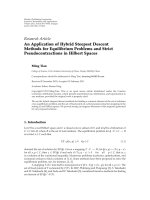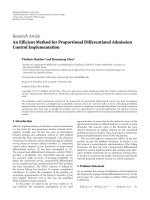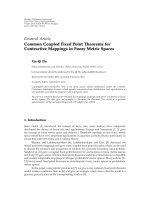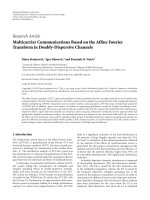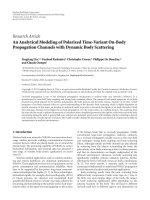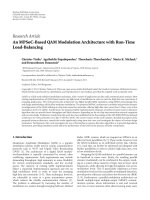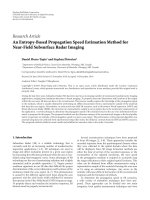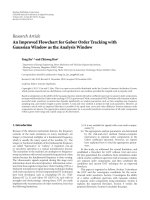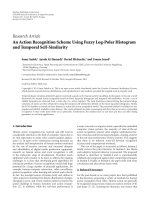Báo cáo sinh học: " Research Article An Upper Bound on the Critical Value β∗ Involved in the Blasius Problem" pot
Bạn đang xem bản rút gọn của tài liệu. Xem và tải ngay bản đầy đủ của tài liệu tại đây (465.8 KB, 6 trang )
Hindawi Publishing Corporation
Journal of Inequalities and Applications
Volume 2010, Article ID 960365, 6 pages
doi:10.1155/2010/960365
Research Article
An Upper Bound on the Critical Value β
∗
Involved
in the Blasius Problem
G. C. Yang
1, 2
1
School of Mathematics and Statistics, Lanzhou University, Lanzhou, Gansu 730000, China
2
College of Mathematics, Chengdu University of Information Technology, Chengdu 610225, China
Correspondence should be addressed to G. C. Yang,
Received 21 February 2010; Revised 29 April 2010; Accepted 6 May 2010
Academic Editor: Michel C. Chipot
Copyright q 2010 G. C. Yang. This is an open access article distributed under the Creative
Commons Attribution License, which permits unrestricted use, distribution, and reproduction in
any medium, provided the original work is properly cited.
Utilizing the Schauder fixed point theorem to study existence on positive solutions of an integral
equation, we obtain an upper bound of the critical value β
∗
involved in the Blasius problem, in
particular, β
∗
< −18733/10
5
−0.18733. Previous results only presented a lower bound β
∗
≥−1/2
and numerical investigations β
∗
.
−0.3541.
1. Introduction
The following third-order nonlinear differential equation arising in the boundary-layer
problems
f
η
f
η
f
η
0on
0, ∞
1.1
subject to the boundary conditions
f
0
0,f
0
β, f
∞
1, 1.2
called the Blasius problem 1, has been used to describe the steady t wo-dimensional flow of
a slightly viscous incompressible fluid past a flat plate, where η is the similarity boundary-
layer ordinate, fη is the similarity stream function, and f
η and f
η are the velocity and
the shear stress functions, respectively.
Problem 1.1-1.2 also arises in the study of the mixed convection in porous media
2. The mixed convection parameter is given by β 1 ε,withε R
a
/P
e
where R
a
is the
2 Journal of Inequalities and Applications
Rayleigh number and P
e
the P
´
eclet number. The case of β<0 corresponds to a flat plate
moving at steady speed opposite to that of a uniform mainstream 3.
The boundary value problem 1.1-1.2 has been widely studied analytically. Weyl 4
proved that 1.1-1.2 has one and only one solution for β 0; Coppel 5 studied the case
of β>0; the cases of 0 <β<1 6 and β>1 7 were also investigated, respectively. Also, see
8. Blasius problem is a special case of the Falkner-Skan equation, for β 0; we may refer to
9–13 for some recent results on the Falkner-Skan equation.
Very recently, Brighi et al. 14 summarized historical study on the Blasius problem
and analyzed the case β<0 in details, in which the shape and the number of solutions were
determined. We may refer to 14 and the references therein for more recent results.
However, up to today, we know only that there exists a critical value β
∗
∈ −1/2, 0
such that 1.1-1.2 has at least a solution for β ≥ β
∗
, no solution for β<β
∗
15. Numerical
results showed that β
∗
.
−0.3541 15.
An open question is what is exactly β
∗
? To our knowledge, there is little study on it.
In this paper, we will study the open question mentioned above by studying the
existence on positive solutions of an integral equation and present an upper bound of β
∗
,
in particular, β
∗
< −18733/10
5
−0.18733.
2. An Upper Bound of β
∗
By the basic fact in 14, we know easily that if f is a solution of 1.1-1.2, then f
> 0for
η ∈ 0, ∞. In this case, the most powerful method is the so-called Crocco transformation see
14, 15, which consists of choosing t f
as independent variable and expressing z f
as
a function of t.Differentiating zf
f
the variable t is omitted for simplicity,weobtain
z
f
f
f
−ff
; hence z
f
−f.Differentiating once again, we obtain z
f
f
−f
.
Then 1.1-1.2 becomes the Crocco equation 14
d
2
z
dt
2
−
t
z
,β≤ t<1
2.1
with the boundary conditions
z
β
0,z
1
0. 2.2
Integrating 2.1 from β to t, we have
z
t
−
t
β
s
z
s
ds on
β, 1
.
2.3
Integrating this equality from t to 1, we obtain the following integral equation that is
equivalent to 2.1-2.2:
z
t
1
t
s
1 − s
z
s
ds
1 − t
t
β
s
z
s
ds for t ∈
β, 1
.
2.4
Journal of Inequalities and Applications 3
Let gβ1/3 − 81 − ββ
2
for β ∈ −1/2, 0, then g
β−82β − 3β
2
> 0forβ ∈
−1/2, 0. By direct computation
g
−
1
5
< 0,g
−
18733
10
5
> 0. 2.5
Hence there exists
β ∈ −1/5, −18733/10
5
such that g
β0andgβ > 0forβ ∈
β, 0.
We shall prove that 1.1-1.2 has at least a solution for β ∈
β, 0.
Let β ∈
β, 0 and Cβ, 1 be the Banach space of continuous functions on β, 1 with
the norm z max{|zt| : t ∈ β, 1} and S : Cβ, 1 → Cβ, 1 with Sztmax{z
t,ct},
where ctc
β
1 − t for t ∈ β, 1 and
c
β
√
3/3 −
g
β
4
1 − β
.
2.6
Clearly, Szt ≥ ct for z ∈ Cβ, 1 and 0 <c
β
≤
√
3/12.
Notation. One has
Az
t
1
t
s
1 − s
Sz
s
ds, Bz
t
t
β
s
Sz
s
ds for β ≤ t<1.
2.7
We consider the following integral equation of the form
z
t
Az
t
1 − t
Bz
t
for β ≤ t<1. 2.8
Lemma 2.1. The integral equation 2.8 has a solution z ∈ Cβ, 1.
Proof. Let C {z ∈ Cβ, 1 : z≤2M} with M
1
β
1 −s|s|/csds. We define an operator
T on C by setting
Tz
t
⎧
⎨
⎩
Az
t
1 − t
Bz
t
if t ∈
β, 1
,
0ift 1.
2.9
Since
Az
t
1
t
s
1 − s
Sz
s
ds ≤
1
t
s
c
β
ds
1 − t
2
2c
β
for t ∈
0, 1
,
t
0
s
Sz
s
ds ≤
t
0
1
c
β
1 − s
ds −
ln
1 − t
c
β
for t ∈
0, 1
,
lim
t →1
−
1 − t
ln
1 − t
0,
2.10
4 Journal of Inequalities and Applications
we know that lim
t →1
−
Tzt0 and then T maps C into Cβ, 1. We show that T is continuous
and compact from C into C.
Let z
n
∈ C, z ∈ C, and lim
n →∞
z
n
−z 0. Since 1 −t ≤ 1 −s for β ≤ s ≤ t ≤ 1, we have
|
Tz
n
t
− Tz
t
|
≤
|
Az
n
t
− Az
t
|
1 − t
|
Bz
n
t
− Bz
t
|
≤
1
β
s
1 − s
Sz
n
s
−
s
1 − s
Sz
s
ds
1
β
s
1 − s
Sz
n
s
−
s
1 − s
Sz
s
1 − t
1 − s
ds
≤ 2
1
β
s
1 − s
Sz
n
s
−
s
1 − s
Sz
s
ds.
2.11
Since
lim
n →∞
s
1 − s
Sz
n
s
1 − s
s
Sz
s
for s ∈
β, 1
2.12
and Szt ≥ ct, the Lebesgue dominated convergence theorem, the dominated function
Fs1/c
β
for s ∈ β, 1 implies that Tz
n
− Tz→0, that is, T is continuous.
By dTzt/dt −
t
β
s/Szsds, we have
d
Tz
t
dt
≤
t
β
|
s
|
Sz
s
ds ≤
t
β
|
s
|
c
s
ds for β ≤ t<1.
2.13
Noticing that
1
β
t
β
|
s
|
c
s
ds dt
1
β
1
s
|
s
|
c
s
dt ds
1
β
1 − s
|
s
|
c
s
ds M<∞,
2.14
we have
1
β
|dTzs/ds|ds ≤ M. This, together with the absolute continuity of the Lebesgue
integral, implies that T C{Tzt : z ∈ C} is equicontinuous.
On the other hand,
|
Tz
t
|
≤
1
t
|
s
|
1 − s
Sz
s
ds
t
β
|
s
|
1 − t
Sz
s
ds
≤
1
β
|
s
|
1 − s
c
s
ds
1
β
|
s
|
1 − s
c
s
ds 2M.
2.15
It follows from the Schauder fixed point theorem that there exists z ∈ C such that 2.8 holds.
Journal of Inequalities and Applications 5
Theorem 2.2. The problem 1.1-1.2 has at least a solution for β ∈
β, 0 and then β
∗
<
−18733/10
5
−0.18733.
Proof. We first prove that the function z obtained in Lemma 2.1 is a solution of 2.4 for β ∈
β, 0. Clearly, we have only to prove Sztzt for t ∈ β, 1,thatis,zt ≥ ct for t ∈ β, 1.
First of all, we prove that there exists t ∈ β, 1 such that zt >ct. In fact, if zt ≤ ct
for t ∈ β, 1, then by Sztc
β
1 − t
c
β
1 − β
≥ z
β
1
β
s
1 − s
Sz
s
ds
1
β
s
1 − s
c
s
ds
1
2c
β
1 − β
2
.
2.16
This implies that c
2
β
≥ 1 β/2 ≥ 1 − 1/5/2 2/5, which contradicts c
β
≤
√
3/12.
From the relations
z
t
−
t
β
s
Sz
s
ds, z
t
−
t
Sz
t
,
2.17
we know that z is convex and increasing on β, 0 and concave on 0, 1. Moreover, since
z10, there exists
t ∈ 0, 1 such that z
tmax{zt : t ∈ β, 1}.
For t ∈
t, 1, we have Bzt ≥ Bz
t−z
t0. Then, from 2.8 we deduce that
Azt ≤ zt ≤ Szt for t ∈
t, 1 and hence
Az
t
−Az
t
≤ t
1 − t
for t ∈
t, 1
. 2.18
Integrating the last inequality for
t to 1 and using Az10, we know that
Az
t
2
2
≤
1
t
s
1 − s
ds ≤
1
0
s
1 − s
ds
1
6
.
2.19
And then z
tAz
t ≤
√
3/3. This, together with ct ≤ c
β
≤
√
3/12 for t ∈ 0, 1, implies
that Szt ≤
√
3/3fort ∈ 0, 1. Hence
1
0
s
1 − s
Sz
s
ds ≥
1
0
s
1 − s
√
3/3
ds
√
3
6
.
2.20
Noticing that Szt ≥ ct and t1 − t < 0fort ∈ β, 0,weobtain
0
β
s
1 − s
Sz
s
ds ≥
0
β
s
1 − s
c
s
ds −
β
2
2c
β
.
2.21
Then
z
β
1
β
s
1 − s
Sz
s
ds
0
β
s
1 − s
Sz
s
ds
1
0
s
1 − s
Sz
s
ds ≥
√
3
6
−
β
2
2c
β
.
2.22
6 Journal of Inequalities and Applications
By direct computation, we have
√
3/6 − β
2
/2c
β
c
β
1 − β and then zβ ≥ cβ. Since z
is convex and increasing on β, 0 and concave on 0, 1 with z10, we immediately get
zt ≥ ct for t ∈ β, 1. Hence Sz z and z is a positive solution of 2.4.
Since any positive solution of 2.1-2.2 is a solution of 1.1-1.214 and 2.1-2.2
is equivalent to 2.4, hence 1.1-1.2 has at least a solution for β
∈
β, 0 and we obtain the
desired result β
∗
≤
β<−18733/10
5
−0.18733.
Acknowledgments
The author would like to thank very much Professors C. K. Zhong and W. T. Li in Lanzhou
University, China, for their guidance and the referees for their valuable comments and
suggestions. This research is supported in part by the Training Fund of Sichuan Provincial
Academic and Technology Leaders.
References
1 H. Blasius, “Grenzschichten in Fl
¨
ussigkeiten mit kleiner Reibung,” Zeitschrift f
¨
ur angewandte
Mathematik und Physik, vol. 56, pp. 1–37, 1908.
2 E. H. Aly, L. Elliott, and D. B. Ingham, “Mixed convection boundary-layer flow over a vertical surface
embedded in a porous medium,” European Journal of Mechanics. B, vol. 22, no. 6, pp. 529–543, 2003.
3 P. D. Weidman, “New solutions for laminar boundary layers with cross flow,” Zeitschrift f
¨
ur
Angewandte Mathematik und Physik, vol. 48, no. 2, pp. 341–356, 1997.
4 H. Weyl, “On the differential equations of the simplest boundary-layer problems,” Annals of
Mathematics, vol. 43, pp. 381–407, 1942.
5 W. A. Coppel, “On a differential equation of boundary-layer theory,” Philosophical Transactions of the
Royal Society of London. Series A, vol. 253, pp. 101–136, 1960.
6 P. Hartman, Ordinary Differential Equations, John Wiley & Sons, New York, NY, USA, 1964.
7 Z. Belhachmi, B. Brighi, and K. Taous, “On the concave solutions of the Blasius equation,” Acta
Mathematica Universitatis Comenianae, vol. 69, no. 2, pp. 199–214, 2000.
8 O. A. Oleinik and V. N. Samokhin, Mathematical Models in Boundary Layer Theory, vol. 15 of Applied
Mathematics and Mathematical Computation, Chapman & Hall/CRC Press, Boca Raton, Fla, USA, 1999.
9 J. Wang, W. Gao, and Z. Zhang, “Singular nonlinear boundary value problems arising in boundary
layer theory,” Journal of Mathematical Analysis and Applications, vol. 233, no. 1, pp. 246–256, 1999.
10 R. P. Agarwal and D. O’Regan, “Singular integral equations arising in Homann flow,” Dynamics of
Continuous, Discrete & Impulsive Systems. Series B, vol. 9, no. 4, pp. 481–488, 2002.
11 G. C. Yang and K. Q. Lan, “The velocity and shear stress functions of the Falkner-Skan equation
arising in boundary layer theory,” Journal of Mathematical Analysis and Applications, vol. 328, no. 2, pp.
1297–1308, 2007.
12 G. C. Yang, “New results of Falkner-Skan equation arising in boundary layer theory,” Applied
Mathematics and Computation, vol. 202, no. 1, pp. 406–412, 2008.
13
K. Q. Lan and G. C. Yang, “Positive solutions of the Falkner-Skan equation arising in the boundary
layer theory,” Canadian Mathematical Bulletin, vol. 51, no. 3, pp. 386–398, 2008.
14 B. Brighi, A. Fruchard, and T. Sari, “On the Blasius problem,” Advances in Differential Equations, vol.
13, no. 5-6, pp. 509–600, 2008.
15 M. Y. Hussaini and W. D. Lakin, “Existence and nonuniqueness of similarity solutions of a boundary-
layer problem,” The Quarterly Journal of Mechanics and Applied Mathematics, vol. 39, no. 1, pp. 15–24,
1986.
